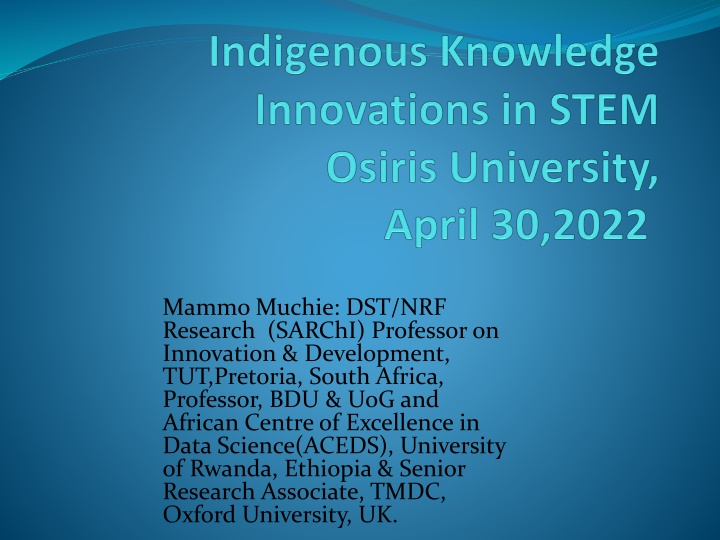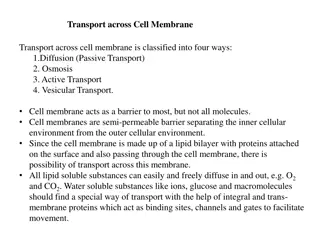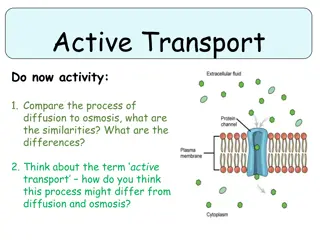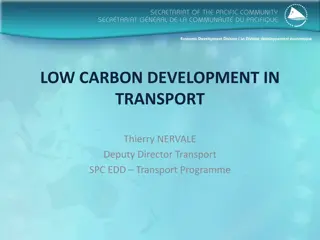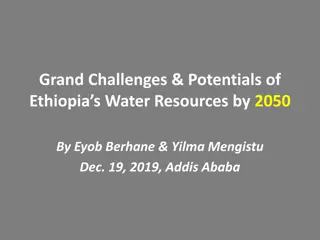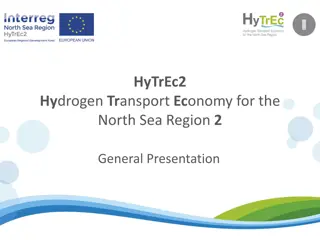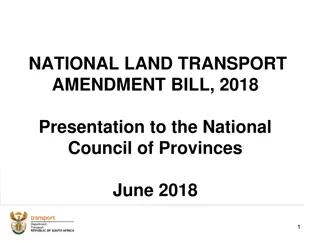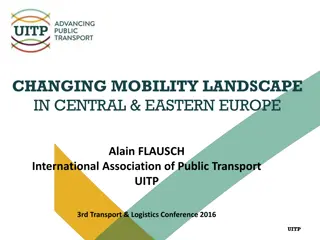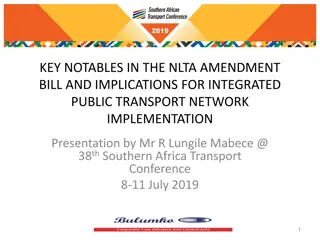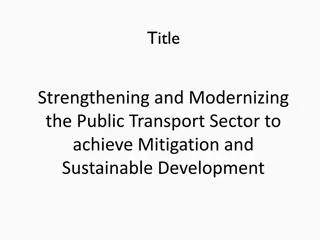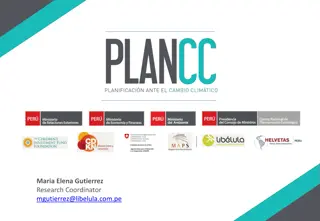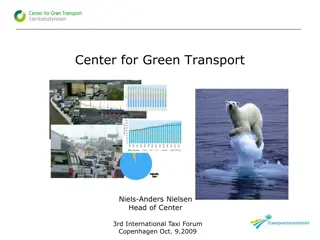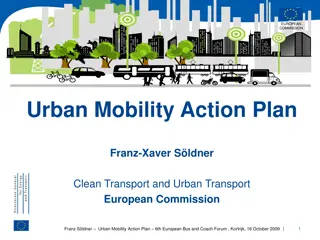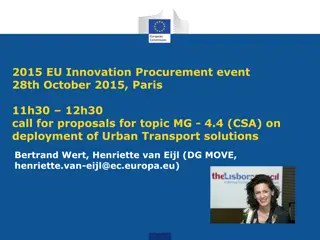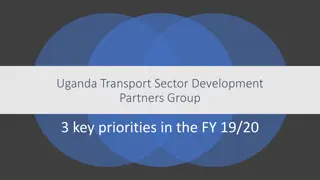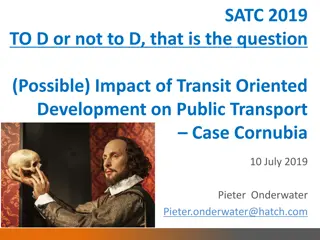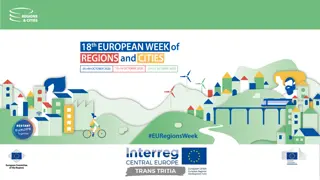Sustainable Transport Strategies for Europe by 2050
European road transport can further reduce its environmental footprint through strategies like reducing transport volume, increasing environmental efficiency, and addressing user perspectives on sustainable commuting habits and policy-making. These efforts aim to promote cleaner fuels, enhance vehicle efficiency, and optimize transport modes for a greener future.
Download Presentation

Please find below an Image/Link to download the presentation.
The content on the website is provided AS IS for your information and personal use only. It may not be sold, licensed, or shared on other websites without obtaining consent from the author.If you encounter any issues during the download, it is possible that the publisher has removed the file from their server.
You are allowed to download the files provided on this website for personal or commercial use, subject to the condition that they are used lawfully. All files are the property of their respective owners.
The content on the website is provided AS IS for your information and personal use only. It may not be sold, licensed, or shared on other websites without obtaining consent from the author.
E N D
Presentation Transcript
Mammo Muchie: DST/NRF Research (SARChI) Professor on Innovation & Development, TUT,Pretoria, South Africa, Professor, BDU & UoG and African Centre of Excellence in Data Science(ACEDS), University of Rwanda, Ethiopia & Senior Research Associate, TMDC, Oxford University, UK.
Outline Inspiration Significance of STEM DEFINTIONS of STEM: Science and Technology Definition: Engineering Definition: Mathematics STEM: When Put Together African Roots of STEM Indigenous vs. Scientific Knowledge Excavating the Science and Technology roots from the African Origin Transforming the African Education Curriculum STEM & IK as part of the Unity of Knowledge African Journal of Science, Technology, Innovation and Development(www.JSTID.com) Concluding Recommendations
Inspiration Africa is a treasure trove not only of Benin bronzes, coltan from the Democratic Republic of the Congo, and diamonds from Botswana. The real unmined gems are African concepts, ideas, values, ways of being and systems of knowledge and episteme. (Oyewumi, p. 4). When I refer to Africa, I mean the sum total of African cultures, as sedimented for millennia in philosophies, wisdoms, ways of knowing, ways of being and doing things as well as of relating to otherness (Olabiyi,Ya , 2008).
Inspiration Sustainable development has to be rooted in the culture, preserving local languages and integrating ancestral practices that are good for the environment. It has to resemble you and where you want your country to go. You can get there by being authentic and you can do that by teaching science in the local language, such as Wolof, a language of Senegal, Gambia and Mauritania. (Khady Sall, in Nature, 2022)
Inspiration The history of Africa, like the history of mankind as a whole, is really the story of an awakening. That story needs rewriting, for it has been considerably distorted by ignorance or self-interest. (Ki-Zerbo (1990, p. 1) A theory is something nobody believes, except the person who made it. An experiment is something everybody believes, except the person who made it. (Albert Einstein)
Inspiration on Africas Challenges The world is still divided by implicit or explicit classifications of inferiority and superiority Africans have not yet fully removed coloniality They still prefer to look and affirm each other by mimicking externality There is still failure to appreciate their full humanity by asserting their rich Africanity
Inspiration African identity continues to be subtracted by a degrading psychic dislocation Africans using external colonial presence by defining themselves with division Like Lusophone Francophone Anglo phone Ethnic phone Language phone Religion phone Gender phone And so on Africa is not a phone
Inspiration Africans must treat one another as one human family Practicing Ubuntu truly Building the Osiris African University with Ubuntu value really
Inspiration Not call some Africans as relatives and others as aliens Africa-philia must replace all- the divisive phones that turn the African one family as strangers Africa must overcome others continued demand to maintain their claims to superiority Africa can reject it by showing there is no justification to continue any form of inferiority By all Africans coming together showing the necessity to recognise full equality To build with the cherished rich African value of ubuntu one in all and all in one humanity
II: Significance of STEM STEM is the integration of Science, Technology, Engineering, and Mathematics into a new unity of knowledge where crossing borders amongst disciplines as a resource for learning and invention is seen as very relevant and significant Education of STEM as a transdciplinary field is new, but the integrated knowledge resource can be enriching for learners to make deeper sense of the world rather than observing through narrow disciplinary lens bits and pieces of phenomena. Indigenous knowledge in STEM has to be included.
DEFINTIONS of STEM: Science and Technology Science is: exploring, understanding, knowing humans, nature and the universe Technology is:the modification of the natural world to meet to human wants and needs. It helps us to improve our health; to grow and processed food and fiber better; to harness and use energy more efficiently; to communicate more effectively; to process data faster and accurately; to move people and things easier; to make products to enhance our lives; and to build structures that provide shelter and comfort. (Source: W.E Dugger, 2010)
Definition of Engineering Engineering is: the profession in which a knowledge of the mathematical and natural sciences gained by study, experience, and practices are applied with judgments to develop ways to utilize economically the materials and forces of nature for the benefit of mankind. (Accreditation Board for Engineering and Technology (ABET, 2002)
Definition: Mathematics Mathematics is: any patterns and relationships represented with the application as the science of numbers and their operations, interrelations, combinations, generalizations, and abstractions and of space configurations and their structure, measurement, transformations, and generalizations (Webster s Ninth New Collegiate Dictionary)
STEM: When Put Together Together they as STEM they reinforce each other with the integration of Science as understanding Technology as modifications of reality Engineering as applied mathematics and science Mathematics as patterns and relationships Combined they can capture the deeper understanding of reality to discover evidence anchored ways to enrich the knowledge universe rather than each moving along isolated trajectories that may not capture fully the real world as best as it can be.
African Roots of STEM The image of the African has been built upon his lowest common denominator (Sertima, 199:30) Africa is the cradle of humanity Civilisation, astronomy, science, mathematics and philosophy originated from Africa There is a real challenge for Africans to understand that the difficult today and tomorrow can be transformed into a beautiful after tomorrow if Africans are prepared to look back to the deep and rich cultural contributions made by the ancestors
Unite Africa with STEM Innovation We must unite now or perish. I am confident that by our concerned effort and determination, we shall lay here the foundations for a continental Union of African States. The struggle against colonialism does not end with the attainment of national independence. We have emerged into independence in a different age, with imperialism grown stronger, more ruthless and experienced, and more dangerous in its international associations. We must recognise that our economic independence resides in our African union and requires the same concentration upon the political achievement. Is it not unity alone that can weld us into an effective force, capable of creating our own progress and making our valuable contribution to world peace? We are fast learning that political independence is not enough to rid us of the consequences of colonial rule. It is said, that we have no capital, no industrial skill, no communications and no internal markets, and that we cannot even agree among ourselves how best to utilise our resources for our own social needs.
Unite Africa with STEM Innovation Yet all stock exchanges in the world are pre-occupied with Africa s gold, diamonds, uranium, platinum, copper and iron ore. We have been too busy nursing our separate states to understand fully the basic need of our union, rooted in common purpose, common planning and common endeavor. We shall link the various states of our continent with communications by land, sea and air. We cannot afford to pace our needs, our development, our security, to the gait of camels and donkeys. For us, it is a simple matter of grasping with certainty our heritage by using the political might of unity. All we need to do is develop with our united strength the enormous resources of our continent. Not one of us working singly and individually can successfully attain the fullest development. Only a united Africa functioning under a union government can forcefully mobilise the material and moral resources of our separate countries and apply them efficiently and energetically to bring a rapid change in the conditions of our people. Unite we must. Without necessarily sacrificing our sovereignties, we can forge a political union based on defence, foreign affairs and diplomacy, and a common citizenship, an African currency, a monetary zone and a central bank. We must unite in order to achieve the full liberation of our continent.
STEM For Competence Building Embedding a total invention, innovation, learning culture Transforming Africa through knowledge , learning , innovation, competence building systems Establishing a Pan African innovation system By learning and building from the past inventions innovation using STEM by Africans for Africa. Using the rich values of Africa (e.g. Ubuntu and MA 'at) to use STEM for innovation without transgressing social and ecological health Building a new learning and innovation integrated STEM driven trajectory by making AUDP/NEPAD very active in African first affirming transformation and innovation system building
Transforming the Education Curriculum STEM education including Indigenous knowledge innovation must be compulsory from primary to tertiary level education All Africans must be exposed to STEM education just like food and water STEM must be seen as the African language for invention, innovation and KLICS STEM should be used for a total transformation of the African education culture and civilisation To change fundamentally the African educational landscape by building from ( not ignoring, neglecting as it is now!) the past African STEM knowledge roots to re-learn and re-think the whole African developmental transformation dynamics
Part II: De-colonising Science and Education: Western vs. Non-Western Science All Non-Western sciences are pre-scientific (Lewis Wolpert) They could not have been any different he claims in his book the Unnatural Nature of Science Epistemological ethnocetrism advocated Greek seen as the cradle of western science Eurocentrism priveleged the Greek origin of western Science
Eurocentric/Western-centric Science If science exploring, understanding, knowing humans, nature and the universe, why start with Greece The emergence of modern science in the West owed major debts to many influences and innovations in Asia, Africa and Arabia Ancient Greek is not alone If not alone why: is it to do with weaving a Eurocentric myth that Greece was the only source of all science and knowledge? .
Eurocentric view of the world Non-European cultures are seen as primitive White people have an obligation to rule the world It is the White Man s burden They must provide cutural development to others coming from the non-West Help them to become western by encouraging or forcing them to adopt western ways To modernise became to be westernised or Europeanised!
Euro-centrism Continues to Dominate Especially since the second half of the 19th century from its early phase in the 18th century Not only was world history rewritten wholesale, but universal social science was new born, not just as a European, but as a Eurocentric invention (Andre Gunder Frank, 1998:14) Eurocentrism provided the foundation of modernisation theory Civilisations like our own Africa gave up their own system to accomodate Eurocentrism, at a great cost! Even China and others did the same. But China and Japan did not go as badly as Africa in falling for the Eurocentric mimickery!
Backlash Against Euro-centrism African science Dogon science in Mali Chinese Science Islamic science Hindu Science Non-Western science Together they reject Greece is the orgin of science They give examples of inventions that did not come from Greece (e. g. Martin Bernal, Needham , Frank and others) They show how the Greeks borrowed from others Argue for cosmopolitanism in science and not Europolitianism or centricism.
Eurocentrism continues to dominate Eurocentrism is still dominant Non-Western science is not acknowldged Not just by the West, but also by the dominated non- west One culture science is still not there There is still raging debates on science
Bridging the Two Cultures Bridging the two cultures (Snow s the Rede Lecture, 1960s) between the arts and humanities on the one hand and the natural sciences on the other hand Transcending dominant academic ethos, organisation, professional interests and communicative languages Dealing with closed language boundaries drawn by the discplines Chasm still continues Two cultures now being played by science vs.sociology
From Two Cultures to the Third Culture Far from the two cultures becoming one culture The opposite trend is occuring There appears to be a third culture that has emerged The social studies of science and technology and the critics by scientists against this social study of science There is as yet No One Culture and NO Science Peace! Instead the science war debate is with us.( see http://sciencewars.tripod.com/)
Science Wars Science wars fought between those who wish to guard the epistemological purity of science The first salvo of the Science Wars was fired in 1992 with the publication of two popular works, one by an American physicist (Dreams of a Final Theory by Steven Weinberg) and the other by a British biologist (The Unnatural Nature of Science by Lewis Wolpert) In 1994, a biologist and a mathematician, Paul Gross and Norman Levitt, published the first full- length work devoted to these developments (Higher Superstition)
Opposing Inter-disciplinarily of science And those that claim science must be studied by including social and cultural contexts Social studies of science introduces relativism Relativism say realist scientists will bring negative impact on science Negative impact on the funding of science Public support may decrease if science is relativised Building one culture opens science to relativism Science wars became heated by Alan Sokal s article in Social Text on the social-cultural interepretation of the theory of quantum gravity
Science War Continues.. Sokal got away with the peer reviewers and got the paper published He then said the social studies of science crowd is not serious If some one uses post-modernist jargons s/he can get away with murder, publish any paper The science wars turned nasty after the hoax In 1994 the Durham conference brought all the science war participants where I was also a speaker defending Africa s contribution to Science After that the science wars site was established The Journal Social Epistemology carried debates. Steve Fuller wrote his book Science
Is there a Science Peace? How to change science wars into peace An edited book called One Culture: a conversation about science.. came out in 2001 Symbolically powerful since it got co-edted by natural and social scientists: J. A. Labinger(natural) and H. Collins (social) Despite such overtures at peace making the science wars continue The social scientists are seen to dislike science Said to have a shared tone -hostility to science Mission needed by scientists to rescue science from those who are hostile
The Real Difference? No problem to produce historical and social theories of science (e.g. J..D Bernal, in the 40s and Thomas Khun in the 60s) Problem lies when social scientists arrogate intellectual capacity to evaluate empirically scientific epistemic content And when they claim to produce theories denying the objectivity and truth claims of scientific knowledge No relativism can either prove truth or validate falsity in the science enterprise applying the logic of symmetry No social constructionism Post-modernism Social scientists unqualified to delegitimise science Social Scientists become Science bashers
The fight goes on Scientists always stomp around meetings talking about bridging the two-culture gap , but when scores of people from outside the sciences begin to build just that bridge, they recoil in horror and want to impose the strangest of all gags on free speech since Socrates: only scientists should speak about science! Bruno Latour complained about scientists
Dispute persists Sociologists promote the post-modern view that all reality is socially constructed including science . Thus the laws of science too are socially constructed Most natural scientists see science as being completely asocial. They believe that science proceeds logically and rationally uncontaminated by the social and cultural.
From the dispute of Science to Knowledge Knowledge too has different modes of being Mode I is discplinary based and narrow Mode II is interdiscplinary and interactive opening the knowldge space for exchange and communication (M. Gibbons) Mode III knowledge adds to interdiscplinary knowledge what my good friend Prof. Andrew Jamison characterises as the hybrid imagination Each mode has claims to epistemological purity and theories of research to create knowledge This classification is within modern scientific knowledge of science, technology,engineering and mathematics It does not address the important knowledge that is classified as indigenous knowledge, broad based innovation and community level knowldge.
From Indigenous to Scientific Knowledge Knowledge like the two cultures of science has both indigenopus and scientific characteristics The Mode I to III classification is within modern scientific knowledge of science,technology, engineering and mathematics . It does not address the important knowledge that is classified as indigenous knowledge, broad based innovation and community level knowledge
What is Indigenous Knowledge But indigenous knowledge cannot be ignored IK is very relevant and it is also called traditional and local knowledge IK is a product of cultures, traditions, values, beliefs, experience transmitted from generations Not universities and the academy Though it needs universities, Governments and academies to excvate, record, code and develop IK.
Difference between IK and SK IK subordinate;SK dominant IK thinking style intuitive;SK analytical reductionist IK communication approach is mainly, oral, story telling, experiential SK is academic, positivist and objective IK explanation.. Spirtual, inexplicable, SK, scientific hypothesis, laws etc
Indigenous Knowledge is Getting Recognition Indigenous knowldge recognised for social and economic development at the rural and community levels (e.g. World Bank, UNESCO, UNDP, UNIDO etc) The challenge is how to develop IK by organising a knowledge peace that leads to a positive sum game between IK and scientific knowldge, technology and engineering Keep the identity of IK even when promoting SK with STEM To bring out the transformative components from IK by integrating with STEMI-modern science, technology, engineering, mathematics and innovation
Link IK with SK Four steps can be taken to link IK with STEM Socialisation Externalisation Combined innovation Internalisation or embedding
Socialisation Promotes knowldge and experience exchange through engagement in social activitiese.g. informal meetings, living together, discussion etc .
Externalisation Transforms socialised tacit knowledge gained to explicit knowledge by creating concepts that can be understood and exchanged
Combined Innovation Transforms explicit knowledge into more systemic form making explicit knowldge to be communicated, diffused and systematised
Internalisation or embedding Makes explict knowldge to be embedded into tacit knowledge, making it more complex and dynamical
African Roots of STEM The image of the African has been built upon his lowest common denominator (Sertima, 199:30) Africa is the cradle of humanity Civilisation, astronomy, science, mathematics and philosophy originated from Africa
Examples from Africa: Mathematics Proto-maths: Lebombo bone (S.A./Swaziland) ~35,000 B.C.; Ishango bone (Congo)~25,000 B.C. Ancient Egypt: Ahmose (Rhind) mathematical papyrus ( )~1650 BC, Moscow papyrus Sona Geometry (Angola) symmetrical, monolinear. Basis for new mathematical ideas like mirror curves and various classes of matrices (cycle, cylinder, helix)- (Gerdes, 2009) African fractals (West and Central Africa) repeating geometric patterns at various scales used in textiles, paintings, sculpture, cosmologies, architecture, town planning. Fractals are the basis of the worldwide web (Eglash, Odumosu, 2005) Binary logic in Yoruba culture for both computation and metaphysics (Segla, 2010)
African Examples: Physics, Chemistry, Engineering and Astronomy Physics/Mechanics/Engineering The level, the screw, Archimedes principle , C.A. Diop (nuclear physics), Abdou Moumouni Dioffo (Solar physicist), Edouard Adjanohoun (Botanist) Chemistry/Metallurgy/Ceramics Iron age (Southern Africa) ~ 2600 BC-1500 BC, Metallurgy of Iron (steel) ~ 900 BC, Benin Bronze, Indigenous/artisanal mining (Chirikure, 2009) Medicine Imhotep (Father of Medicine), Peseshet (first woman surgeon, 4th dynasty), Charles Drew (blood transfusions) Astronomy Ancient Egypt (solar calendar), Dogon (Sirius B), Benjamin Banneker (surveyor, astronomer)
African Philosophy African Concept of Personhood, Communalism, African humanism Employed in HIV/Aids prevention campaigns in Uganda and Senegal, Gacaca (reconciliation) in Rwanda Critical retrieval, (Ya , 1999), Sankofa Science (socially-inclusive science) Applied to study of stem cell research in California (Benjamin, 2013) Environmental philosophy Eco-bio-communitarianism (Gwangwa, 2004), Ethics of care, Ethics of nature relatedness (Ogungbemi, 2001) Can be applied to energy policy Epistemology The nature of knowledge, belief, values in Yoruba culture (Hallen and Sodipo, 1997 )
Acknowledgment of African Contribution from Western Research Universities Africans also have originated many scientific discoveries. Evidence has been acknowledged by astronomers and engineers from Western Research universities that in many major inventions, documented contributions have been made by Africans. Carbon steel was made 2000 years ago in Tanzania; astronomical observations in the Mali of the Dogons have been acknowledged by carl Segall of Cornell University, language, mathematical systems, architecture, agriculture, and cattle-rearing, navigation of inland water ways and open seas, medicine and communication, writing systems in all these fields Africans have been inventors!
African Contribution: Agriculture African knowledge in agriculture is rich. This has been recognised and acknowledged fully by the US Academy of Science in 1996 that Africa has more native cereals than any other continent. It has its own species of rice, as well as finger millet, fonio, peral millet, sorghum, teff, guinea millet, and several dozen wild cereals whose grains are eaten. This is a food heritage that has fed people for generations, possibly stretching back to the origins of mankind. It is also a local legacy of genetic wealth upon which a sound food future might be built. But strangely, it has been bypassed in modern times . Forward thinking scientists are starting to look at the old cereal heritage with unbiased eyes .Peering past the myths, they see waiting in the shadows a storehouse of resources whose qualities offer promise not just to Africa, but the world. The Ethiopian crop teff is medicine. It has still great potential to be the nutrition for healthy living. Food security in Africa should not be in doubt at all( quoted Muchie et al: Putting Africa First: The Making of African Innovation Systems, Aalborg University Press, 2003, Pp.43-61)
